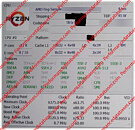- Joined
- Oct 9, 2007
- Messages
- 46,476 (7.66/day)
- Location
- Hyderabad, India
| System Name | RBMK-1000 |
|---|---|
| Processor | AMD Ryzen 7 5700G |
| Motherboard | ASUS ROG Strix B450-E Gaming |
| Cooling | DeepCool Gammax L240 V2 |
| Memory | 2x 8GB G.Skill Sniper X |
| Video Card(s) | Palit GeForce RTX 2080 SUPER GameRock |
| Storage | Western Digital Black NVMe 512GB |
| Display(s) | BenQ 1440p 60 Hz 27-inch |
| Case | Corsair Carbide 100R |
| Audio Device(s) | ASUS SupremeFX S1220A |
| Power Supply | Cooler Master MWE Gold 650W |
| Mouse | ASUS ROG Strix Impact |
| Keyboard | Gamdias Hermes E2 |
| Software | Windows 11 Pro |
Beating previous reports that AMD is increasing the CPU core count of its mobile monolithic processors from the present 8-core/16-thread to 12-core/24-thread; we are learning that the next-gen processor from the company, codenamed "Strix Point," will in fact be the company's first hybrid processor. The chip is expected to feature two kinds of CPU cores, with "Zen 5" being the microarchitecture behind the performance cores, and "Zen 5c" behind the efficiency cores. An engineering sample featuring 4 P-cores, and 8 E-cores, surfaced on the web, thanks to Performancedatabases. A HWiNFO screenshot reveals the engineering sample's core-configuration of 4x P-cores and 8x E-cores, with identical L1 cache sizes. Things get a little fuzzy with the L2 cache size detection, and L3 cache.
We know from the current "Zen 4c" core design that it is essentially a compacted version of "Zen 4" designed for higher-density chiplets that have 16 cores; and that it has both the same ISA and IPC as "Zen 4," with the only difference being that "Zen 4c" is designed with lower amounts of shared L3 caches at their disposal, are generally configured with lower clock speeds, and have higher energy efficiency than "Zen 4." "Zen 4c" cores also 35% smaller in die-area than "Zen 4." The company could develop "Zen 5c" CPU cores with similar design goals.


The "Strix Point" silicon could hence have two CCX (CPU core complexes); one of which has the larger "Zen 5" P-cores and certain amount of L3 cache, and another CCX with the smaller "Zen 5c" cores, and their own L3 caches. This would essentially be similar to "Renoir," which has two 4-core CCXs of "Zen 2" cores. The L1 cache sizes for both kinds of cores is identical—48 KB L1D and 32 KB L1I, and it's likely that both core types have 1 MB of dedicated L2 caches per core. The L3 cache sizes could vary between the two CCXs, with the P-core CCX having 16 MB (4 MB per core), and the E-core CCX 8 MB (512 KB per core).
It would be interesting to imagine how AMD handles the hybrid architecture from a software standpoint. Intel uses Thread Director, a hardware-based solution that's designed to send the right kind of compute workload to the right kind of CPU core. AMD could either try to develop its own version of Thread Director, or use a less sophisticated OS-based solution such as what it's doing with its multi-CCD client processors.
View at TechPowerUp Main Site | Source
We know from the current "Zen 4c" core design that it is essentially a compacted version of "Zen 4" designed for higher-density chiplets that have 16 cores; and that it has both the same ISA and IPC as "Zen 4," with the only difference being that "Zen 4c" is designed with lower amounts of shared L3 caches at their disposal, are generally configured with lower clock speeds, and have higher energy efficiency than "Zen 4." "Zen 4c" cores also 35% smaller in die-area than "Zen 4." The company could develop "Zen 5c" CPU cores with similar design goals.


The "Strix Point" silicon could hence have two CCX (CPU core complexes); one of which has the larger "Zen 5" P-cores and certain amount of L3 cache, and another CCX with the smaller "Zen 5c" cores, and their own L3 caches. This would essentially be similar to "Renoir," which has two 4-core CCXs of "Zen 2" cores. The L1 cache sizes for both kinds of cores is identical—48 KB L1D and 32 KB L1I, and it's likely that both core types have 1 MB of dedicated L2 caches per core. The L3 cache sizes could vary between the two CCXs, with the P-core CCX having 16 MB (4 MB per core), and the E-core CCX 8 MB (512 KB per core).
It would be interesting to imagine how AMD handles the hybrid architecture from a software standpoint. Intel uses Thread Director, a hardware-based solution that's designed to send the right kind of compute workload to the right kind of CPU core. AMD could either try to develop its own version of Thread Director, or use a less sophisticated OS-based solution such as what it's doing with its multi-CCD client processors.
View at TechPowerUp Main Site | Source







